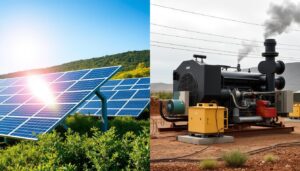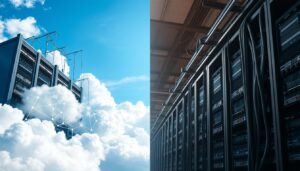The digital world is growing fast, and so is its impact on the environment. By January 2020, there were 1.74 billion websites online. These sites use a lot of energy, releasing 2,330,041 tons of CO2 every day.
Every search online uses about 0.3 Wh of energy. This also means 0.2g of CO2 is released. These numbers show we need to make our websites more eco-friendly.
Key Takeaways
- The internet’s energy consumption and carbon emissions are significant, contributing to global environmental challenges.
- Adopting eco-friendly practices in web development and online presence can make a meaningful impact on reducing the carbon footprint.
- Optimizing website performance, choosing green hosting providers, and implementing sustainable coding practices are crucial steps towards an eco-friendly website.
- Continuous monitoring and improvement of website efficiency can further enhance the environmental sustainability of your online presence.
- Educating stakeholders and customers about the importance of eco-friendly websites can foster a more environmentally conscious digital landscape.
Introduction: The Environmental Impact of Websites
As owners of eco websites, we must think about how our online presence affects the environment. The internet is a powerful tool for connecting and sharing information. But, it also adds a lot to global carbon emissions.
Internet use is estimated to cause 3.7% of global greenhouse gas emissions. This is as much as all air traffic in the world.
Statistics on Website Usage and Energy Consumption
Information and Communication Technologies (ICT) use 6-10% of global power. This means 4% of our greenhouse gas emissions. This number could double by 2025, unless the COVID-19 pandemic’s effects last.
The internet causes 400kg of CO2 emissions per person yearly. It would take 16 years for a grown tree to offset this.
The Need for a Stringent Green IT Framework
With websites using more energy and people caring more about the environment, we need a strong green IT framework now more than ever. By using sustainable web development, we can cut down our eco website‘s carbon emissions and energy consumption. This helps make the future more sustainable.
Assess Your Website’s Carbon Footprint
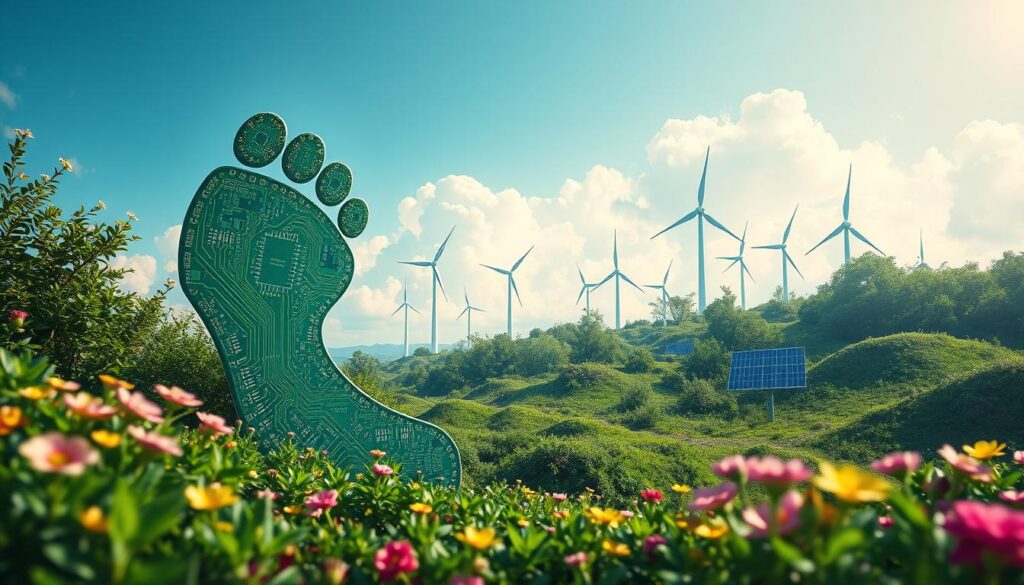
Measuring your website’s environmental impact is the first step to reduce its carbon footprint. There are free tools to help you calculate your website’s carbon emissions. These tools can also show you how to improve.
Tools to Calculate Your Website’s Carbon Emissions
The Website Carbon Calculator by Wholegrain Digital is a popular tool. It grades your website’s emissions from A to F. It looks at performance, efficiency, and user experience.
It says the average web page produces 1.76 grams of CO2 per view. For a website viewed by 10,000 people monthly, that’s 211 kg of CO2. This is like drinking two coffees a day for about 5 years.
Ecograder by Mightybytes also offers a detailed analysis. It checks your website’s sustainability and gives tips for better performance. The Blacklight tool finds tracking scripts that increase your website’s carbon emissions.
Google’s Lighthouse tool gives insights on performance, accessibility, and SEO. These areas can also affect your website’s environmental impact.
By using these tools, you can find ways to lower your website’s carbon footprint. This helps reduce your environmental impact.
| Tool | Key Features | Rating Scale |
|---|---|---|
| Website Carbon Calculator | Estimates CO2 emissions per page view, compares to global average | A to F |
| Ecograder | Analyzes sustainability, provides recommendations for improvement | Score out of 100 |
| Blacklight | Detects high-impact tracking scripts contributing to emissions | N/A |
| Google Lighthouse | Evaluates performance, accessibility, and SEO optimization | Score out of 100 |
Choose a Green Web Host
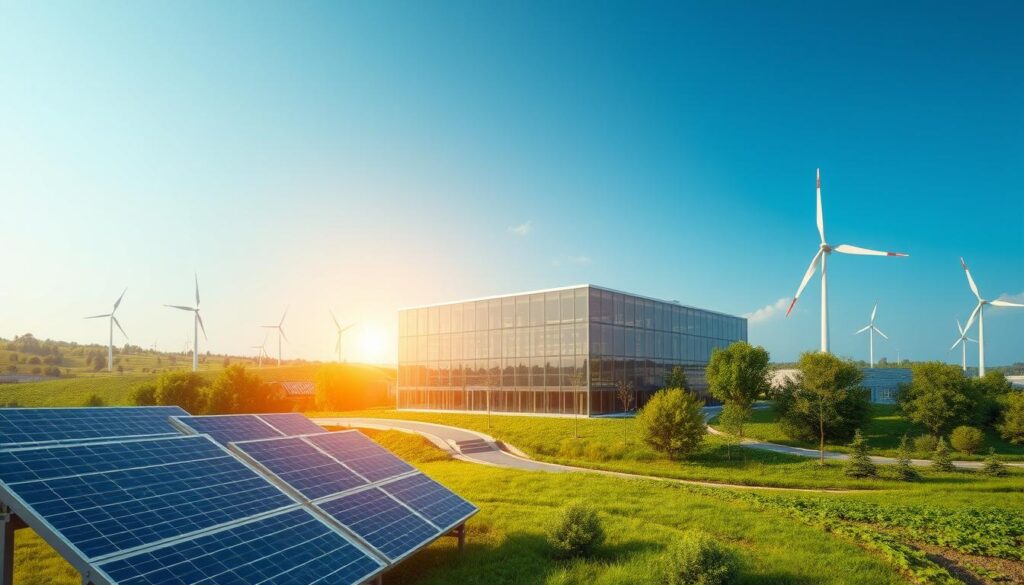
Choosing the right web host is key to making your website eco-friendly. Data centers use a lot of energy, often from coal and gas. But, many green web hosting providers are now offering sustainable options to help you reduce your carbon footprint.
Importance of Using Renewable Energy for Hosting
Using a web host that gets its power from renewable energy is a big step. This means using wind, solar, or water power. By picking a sustainable web hosting provider, you help keep fossil fuels in the ground and cut down on harmful emissions.
Identifying Eco-Friendly Web Hosts
- Find hosting companies that openly talk about their green efforts, like using clean energy or reducing waste.
- Look for third-party stamps of approval, like the Green Web Foundation’s list, which shows green web hosting providers.
- Choose hosts that offer renewable energy credits (RECs) or carbon offsets to balance out their impact.
- Go for hosts known for being reliable, secure, and good at customer service. These qualities help make your website more sustainable.
By picking a green web hosting provider, you make a big difference. It’s good for the planet and can draw in eco-aware visitors. Plus, it makes your website better for everyone.
Optimize Images and Content Delivery
As a website owner, it’s key to optimize images and content delivery. Big images use more resources, leading to more energy use. By making images smaller and using less resolution, we can make web pages load faster. This makes users happy and helps the planet.
Techniques for Image Optimization
Here are some ways to make images better for your website:
- Compression and Format Conversion: Use WebP format for photos to make them 30% smaller. Tools like TinyPNG can also make images 30% smaller without losing quality.
- Resizing and Scaling: Make images the right size before uploading. This makes them load faster and use less space.
- Lazy Loading: Use lazy loading for images that aren’t seen right away. This makes pages load faster and saves energy.
- Accessibility and Layout: Set image sizes to prevent layout shifts. Add alt text for screen readers to make images accessible.
The Role of Caching and Content Delivery Networks (CDNs)
Caching and CDNs are also important for better content delivery and less environmental impact.
A CDN is a network of servers around the world. It makes content reach users faster, using less energy. This also makes websites load faster and work better.
By using these methods, website owners can lessen their environmental impact. They also make their websites faster and more enjoyable for users.
Embrace Sustainable Coding Practices
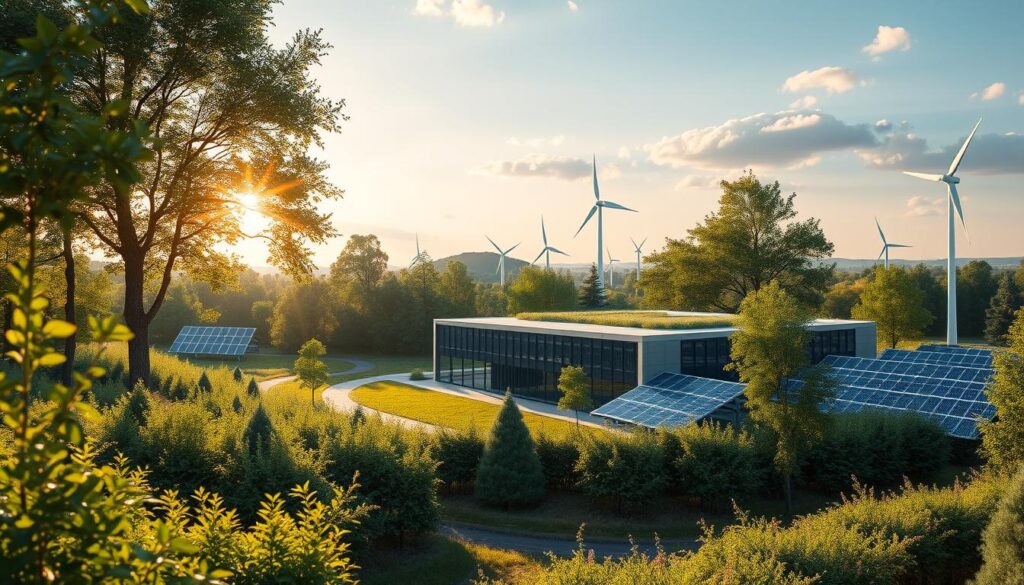
As web developers, we must reduce our environmental impact. Sustainable coding helps lower energy use and carbon footprint. It makes our digital world greener.
Writing clean, efficient code is key. Fewer HTTP requests and less use of plugins help. This makes websites faster and uses less energy.
Tools like Google’s PageSpeed Insights and Lighthouse find ways to improve our code. Following the Sustainable Web Manifesto helps us make greener digital products.
Choosing the right algorithms and data structures is also important. This cuts down CPU cycles, saving energy and making our projects more sustainable.
Staying updated with sustainable coding is vital. Online courses and discussions on green computing keep us informed. This helps us lead in this important field.
By adopting sustainable coding, we help create a better digital future. We also make websites faster and more enjoyable. Together, we can positively impact the planet through our work.
eco website: Adopting Green Web Development
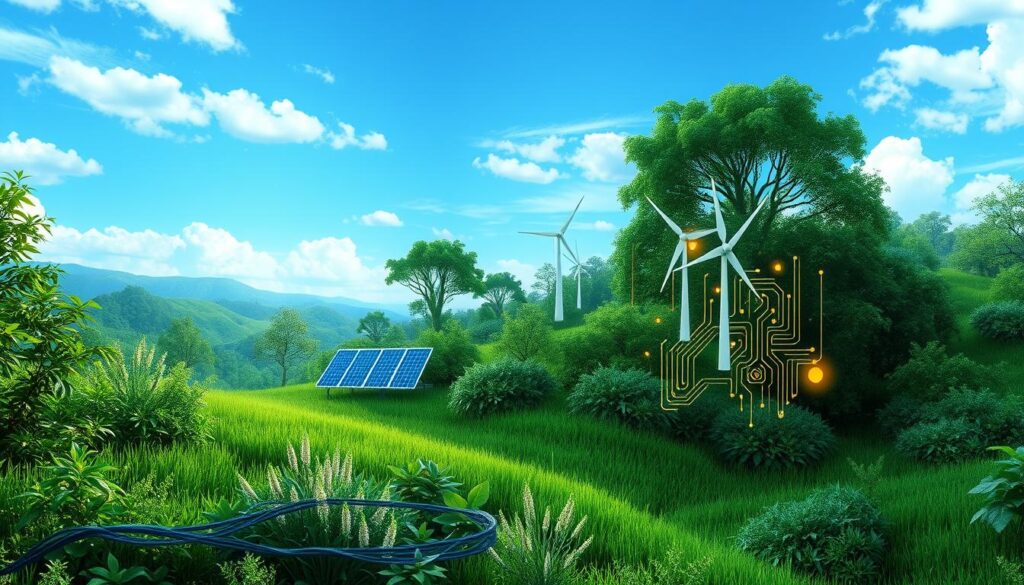
Being an eco-conscious web developer means using green practices. You should use eco-friendly web development, sustainable web design, and green web technologies. This helps lower your website’s environmental impact.
By making your website more efficient, you save energy. This not only cuts down on carbon emissions but also makes your site better for users.
Strategies for Eco-Friendly Web Development
Sustainable web development is about making websites good for the planet. Here are some effective strategies:
- Choose green web hosting that uses clean energy or offsets carbon, like GreenGeeks, Kualo, and EcoHosting.
- Use image optimization with new formats like WebP and AVIF to make images smaller and load faster.
- Apply lazy loading and the Intersection Observer API to only load content when it’s needed, saving energy and data.
- Use Content Delivery Networks (CDNs) to serve content closer to users, cutting down on latency and energy use.
- Employ service workers to cache content and enable offline use, reducing server requests and energy.
- Think about using dark mode to save energy on OLED screens.
By using these sustainable web development methods, you can make websites that look great and are good for the planet. This helps make the digital world a greener place.
Keep checking and improving your site with tools like Lighthouse and WebPageTest. This ensures your green efforts keep making a difference.
Continuously Monitor and Improve
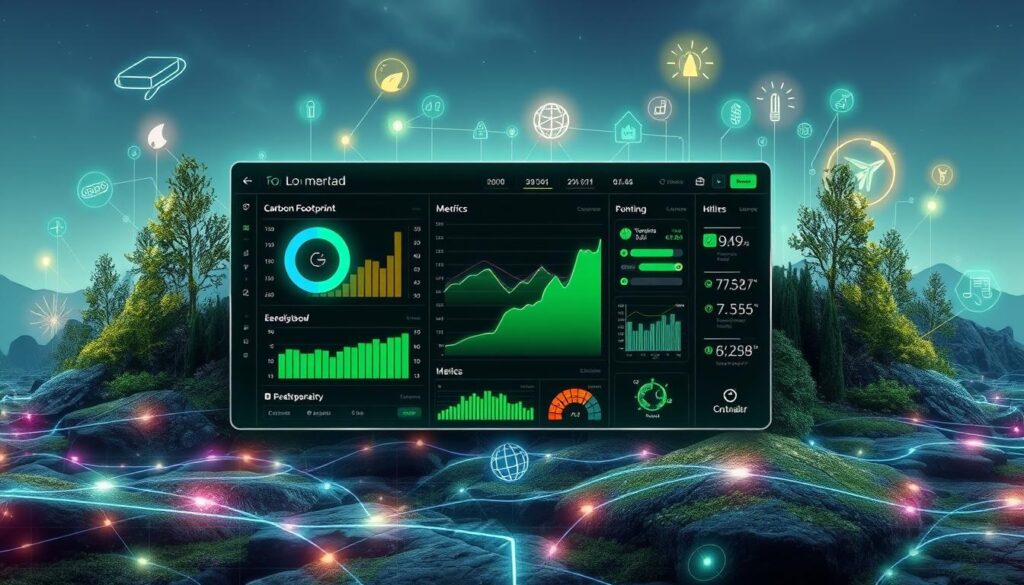
As an eco-conscious business, it’s key to keep checking and improving your website’s carbon footprint. Getting your website completely carbon-neutral might be hard. But, by always trying to make it better, you can keep it green and cut down on harm to the environment.
The Importance of Ongoing Optimization
Even the best eco-friendly websites still make some carbon emissions. This is mainly because of the devices used to access them. It’s vital to keep checking and tweaking to lower these emissions and keep your website’s carbon footprint small.
By continuously monitoring your website’s carbon footprint, you can spot areas to get better. You can then use sustainable web maintenance practices. This might mean making images smaller, improving how content is delivered, and using better coding. You can also look for ongoing optimization ways to lessen your website carbon footprint over time.
| Benefit | Impact |
|---|---|
| Lower electricity, gas, and water consumption and costs | PEAK offers teams the visibility to make smarter, data-driven decisions across portfolios. |
| Hospitals and healthcare facilities use PEAK for maintaining optimal indoor environments | Universities, schools, and educational campuses leverage PEAK for creating and maintaining a comfortable learning environment. |
| Hotels and resorts use PEAK to enhance guest comfort and manage energy consumption | PEAK allows the asset management team to view across the portfolio and ensure that learnings from one asset are applied across many. |
| Centralizing portfolio control through a National Operations Center (NOC) with PEAK enables cost savings, improved client service, and efficient operations across diverse assets | 24/7 monitoring available from a computer, tablet, or smartphone |
By continuously monitoring and improving your website’s sustainable web maintenance, you can make sure it stays eco-friendly. This helps make the internet a greener place for the future.
Benefits of Eco-Friendly Websites
Creating a low-carbon or carbon-neutral website shows you care about the planet. It helps meet any net-zero goals your company has. Also, more people expect businesses to be green, thanks to growing environmental worries.
An eco-friendly site meets these expectations. It makes your brand look good and attracts green-minded people. Plus, these sites are fast and efficient, making everyone happy.
Attracting Environmentally Conscious Customers
An eco-friendly website shows you’re serious about being green. This appeals to people who care about the environment. They’re more likely to choose your brand because it matches their values.
By sharing your green efforts, you stand out. This builds trust and loyalty with customers who value the planet.
Enhancing User Experience and Website Performance
Using green design makes your site faster and more fun to use. This makes your customers happy and helps your site rank better on search engines. Green web development boosts your online image and attracts more eco-aware users.
| Benefit | Description |
|---|---|
| Strengthened Brand Image | Showcasing environmental responsibility and sustainability initiatives through an eco-friendly website can help build a positive brand image and attract environmentally conscious customers. |
| Improved User Experience | Sustainable web design practices, such as image optimization and efficient code, can lead to faster page load times and a more enjoyable user experience. |
| Enhanced Search Engine Optimization | Websites that provide a high-quality, seamless user experience are prioritized by search engines, leading to improved visibility and better search engine rankings. |
| Reduced Environmental Impact | Adopting eco-friendly web development practices can help reduce the carbon footprint of your website, contributing to a more sustainable digital ecosystem. |
Case Studies: Companies Leading the Way
Many companies worldwide have made big steps towards being more eco-friendly. These case studies show how some top companies are going green. They use carbon neutral websites and sustainable business practices, inspiring others to do the same.
Google’s Efforts Towards Carbon Neutrality
Google is a big name in the fight against climate change. They use wind power to run their buildings. They also reuse water to cool their servers, cutting down on waste.
Microsoft is also making big moves. They cool their computers with undersea water. This cuts down on energy use and shows their dedication to being green.
Companies like Sky, Adobe, McKinsey, and Apple have also gone carbon neutral. They show it’s possible and important to be eco-friendly. Their success encourages others to make changes too.
We share these case studies to motivate businesses to go green. Companies of all sizes can learn from these leaders. Together, we can make a difference for our planet.
The Role of Testing and Optimization
I’m all about making websites better for our planet. A/B testing is key in this effort. It helps us make sure our changes are good for the environment and our users.
At VWO, we have a simple plan: Analyze -> Hypothesize -> Test -> Deploy -> Repeat. This cycle helps us make smart choices and improve our site. It fits right into our work without harming the planet.
Working towards a green website is a big job, but it’s worth it. We watch our site’s performance and keep our carbon use low. Teaching others about green web practices is also important to keep everyone on the same page.
A/B Testing for Sustainable Website Changes
A/B testing is a big help in making our site better for the planet. It lets us see how our green changes affect our site and users. This includes things like website optimization and our carbon footprint.
- With A/B testing, we make choices based on facts. This ensures our changes help both our users and the planet.
- Testing and optimizing our site helps us find the best ways to be green. We can then apply these changes with confidence.
- This ongoing process lets us keep making our site better. We’re always working towards being more sustainable and making users happy.
At VWO, we think the future of digital is all about A/B testing, website optimization, and sustainable web development. By using this approach, we can make websites that are great for users and the planet.
Educating Stakeholders and Employees
Creating an eco-friendly website is a team effort. We need everyone’s help to reduce our digital carbon footprint. This means getting our stakeholders and employees involved.
To spread sustainability awareness, we focus on eco-friendly education. A Deloitte survey found 69% of workers want their companies to go green. Younger people, especially Gen Z and Millennials, are eager to make a difference.
We educate our stakeholders and employees on digital environmental impact. We teach them how to help our eco-friendly goals. This includes workshops, emails, and games that encourage green actions.
Empowering our team makes our sustainability journey stronger. Engaged employees are more innovative and loyal. They see the positive impact of their work.
Creating an eco-friendly website is about teamwork. By teaching eco-friendly education and sustainability awareness, we unlock our team’s potential. Together, we can make a greener digital future.
| Key Findings | Percentage |
|---|---|
| Employed adults who want their companies to invest in sustainability | 69% |
| Gen Z and Millennials who believe they can drive organizational change | 64% |
| People who would consider a potential employer’s stance on sustainability | 27% |
| Employees who have contemplated switching jobs for a more sustainable company | 25% |
| C-suite leaders reporting that employees influence their sustainability plans | 80% |
| Leaders acknowledging that employee activism has led to increased sustainability efforts | 59% |
Conclusion
Creating an eco-friendly website helps reduce your company’s environmental harm. Simple steps like optimizing code and using renewable energy for hosting cut down energy use. These actions are good for the planet and make your site faster and cheaper to run.
This guide shows how to make a website that’s kind to the earth. Using green web development shows I care about the planet. It’s also smart for business since more people want to buy from eco-friendly companies.
I will keep working to make my website better for the environment. I’ll watch its impact and make changes as needed. By using the latest green IT, I can help the world while keeping my site running smoothly.
FAQ
Q: What is the current state of website usage and energy consumption?
A: There are about 1.74 billion websites online, with 4 billion+ visitors daily. This has cut down paper use but increased internet pollution. The internet causes 2,330,041 tons of CO2 emissions and uses 2,339,400 MWh of electricity daily.
Q: How can we make the internet a more energy-efficient place?
A: We need a strong green IT framework to keep the internet sustainable. Website owners should think about their environmental impact. They should work to lower their website’s carbon footprint.
Q: How can we calculate the carbon footprint of a website?
A: Each web page emits 1.76 grams CO2 per view. This adds up to 211 kg CO2 yearly for 10,000 monthly views. Use the Carbon Calculator for a more accurate estimate.
Q: Why is choosing a green web host important?
A: Picking a green web host saves energy. Many hosts use non-renewable energy, but some use green data centers. These centers use wind or solar power.
Q: How can we optimize images and content delivery to reduce energy consumption?
A: Make images smaller and use WebP format. Also, use a Content Delivery Network (CDN). These steps lower energy use and carbon emissions.
Q: What are some sustainable coding practices to implement?
A: Developers should reduce HTTP requests and use fewer plugins and scripts. Remove unused code and write clean, efficient code. This makes pages load faster and uses less server time.
Q: How can we offset the remaining carbon emissions from our website?
A: You can’t completely eliminate your website’s carbon emissions. But, you can offset them. Buy carbon offset credits from ecological organizations.
Q: What are the benefits of having a low-carbon website?
A: A low-carbon website shows you care about the environment. It helps meet net-zero targets and builds trust with green stakeholders. It also makes your website faster and easier to use.
Q: How can we educate our users and stakeholders about the importance of eco-friendly websites?
A: Teach users about digital environmental impact. Encourage them to browse less and use energy-saving modes. Make sure your team knows about your green goals and helps achieve them.



